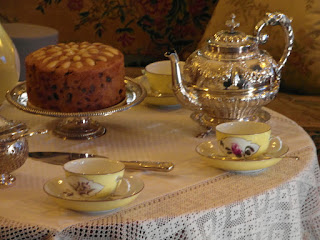This week I spent a fascinating day in the company of an expert from the BBC's popular Antiques Roadshow. I was learning about antique silver and the part it has played in social custom. I'm sure that much of what I learnt is going to add greatly to my enjoyment of works of art.
It would take too long to mention everything here so I'll just touch on a few aspects of the study day.
We began with a painting of a medieval banquet. How pretty, I thought. I'm sure I received an Xmas card that looked very like it last year. But our expert made us look deeper into the picture. He pointed out that the windows would have been unglazed in medieval times. Birds and insects would have been able to come into the banqueting hall very easily. I wasn't sure that his suggestion that the reason why the lords and ladies would sit under a canopy was to protect them from bird droppings, but the idea that covered cups were used to keep the drink clean and fresh was far more plausible. You can see one on the left in the painting below.
Contrary to popular belief, hygiene was not neglected in medieval days. When you were the guest of a wealthy household, you were expected to bring your own knife and would be offered water to wash it and your hands. Plates (trenchers) were usually provided as well as spoons (no forks were in general use until much later on). Incidentally trenchers were mainly square, giving rise to the expression "a square meal".
It was in Tudor times that hygiene became less scrupulous, perhaps because of the growth in population. The Tudors also loved their bling. Something akin to this extraordinary silver ship, known as a nef, would have graced the tables of the rich.
Several hundreds of years later, in the Edwardian era, a beautiful silver teapot like this one would have been an essential ornament to the tea table if you wanted to be fashionable. However it wasn't considered necessary that all the pieces of the tea service should match. It was acceptable for them to have been purchased at different times, or handed down as family heirlooms.
Service at table also changed from "service a la francaise" where many dishes were placed in the centre of the table and people helped themselves, to "service a la russe" shown below where there would be many courses, all served individually by staff. This left more room in the centre of a table for elaborate centrepieces - silver being highly prized. Interesting that the popularity of sharing plates in modern restaurants is, in effect, a return to the idea of "service a la francaise".
and





No comments:
Post a Comment